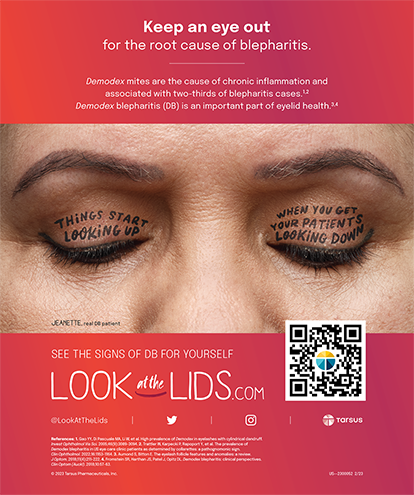What was the most significant surgical or clinical development for your practice in 2012?
Steven J. Dell, MD
A significant development in my practice was the introduction of laser cataract surgery, which represents the first fundamental alteration to the cataract surgical process in many years. I would like, however, to suggest another more significant development. This was the first year that the demographic impact of our aging population affected my practice. Even in my highly competitive market, it became apparent in 2012 that seniors are struggling to find doctors in multiple specialties to care for them, and these patients are increasingly grateful for our services. In a recent survey of 13,575 physicians in the United States, 50% indicated that they are planning to take steps to limit patients' access in the next 1 to 3 years, and 7% said they intend to switch to a cash-only or concierge practice.1
This was also the year that I truly began to understand that the net result of this dramatic shift in the supply of physicians is massive pricing power. The Association of American Medical Colleges projects that, in about 7 short years, there will be a shortage of more than 90,000 physicians.2 In ophthalmology, we are fortunate that many of our services fall outside the realm of insurance. As a result, I have raised my prices on everything from refractions to the surgical correction of astigmatism and presbyopia, and I have not observed a decrease in the percentage of patients choosing these optional items. This is very surprising and contrary to our previous assumptions about the price elasticity of demand for care. Now, I wonder if I have not raised the prices enough.
For too long, ophthalmologists have watched the reimbursement wars and have gradually accepted the notion that what we provide has diminishing value. I reject this idea completely and suggest that what we provide beats the performance of virtually anything else in medicine (or outside medicine). This is particularly true of modern cataract surgery. It is easy to swim with a current, and for the next couple of decades, each year will bring a substantial increase in the number of patients who require cataract surgery, accompanied by a net loss in the number of cataract surgeons. This older group of patients began accumulating wealth during the longest sustained period of economic growth in US history, and they may represent the wealthiest group of people in history. A substantial percentage of this patient population will opt for our noncovered offerings, and market forces will support an increase in those prices.
Mark Kontos, MD
For my practice, the most significant development was the ability to provide corneal collagen cross-linking (CXL) to our patients with keratoconus and ectasia. Empire Eye Physicians, located in Spokane, Washington, is a study site for the US CXL clinical trial, which is evaluating the efficacy of epithelium-on CXL. My colleagues and I began treating patients early this spring, and it has been an energizing experience for our patients, staff, and referring doctors. Personally, it has been very rewarding finally to have an option to offer these patients. Once word got out that this therapy was available in our region, patients began to come from all over the Pacific Northwest, making CXL a true practice builder. Our specialty contact lens practice has grown, and several of these patients have entered our toric IOL pipeline and become very strong referrers for our practice. We have been encouraged by the early results and look forward to expanding our treatment parameters in the future.
Colman R. Kraff, MD
In 2012, our practice acquired a LenSx Laser (Alcon Laboratories, Inc.) for premium cataract procedures. Evaluating the clinical results of laser cataract surgery compared to those of conventional phacoemulsification and incorporating the logistics for educating and processing these patients as well as the business model of this new technology are an ongoing process. The technology will continue to improve. The jury is still out on laser cataract surgery, however, as my colleagues and I continue to integrate this new technology into our practice.
Sonia H. Yoo, MD
The most significant development for my practice was laser cataract surgery. The femtosecond laser allows for more precise corneal wounds, limbal relaxing incisions, lenticular segmentation, and capsulorhexes. Time will tell whether this precision translates into visual improvements over conventional cataract surgery. Laser cataract surgery is exciting, because it represents the potential for cataract surgery to become a truly refractive procedure.
Section Editor John F. Doane, MD, is in private practice with Discover Vision Centers in Kansas City, Missouri, and he is a clinical assistant professor with the Department of Ophthalmology, Kansas University Medical Center in Kansas City, Kansas. Dr. Doane may be reached at (816) 478-1230; jdoane@discovervision.com.
Steven J. Dell, MD, is the director of refractive and corneal surgery for Texan Eye in Austin and chief medical editor of Cataract & Refractive Surgery Today's sister publication Advanced Ocular Care. Dr. Dell may be reached at (512) 327-7000.
Mark Kontos, MD, is the senior partner at Empire Eye Physicians in Spokane, Washington. Dr. Kontos may be reached at (509) 928-8040; mark.kontos@empireeye.com.
Colman R. Kraff, MD, is the director of refractive surgery for the Kraff Eye Institute in Chicago. He acknowledged no financial interest in the procuct or company he mentioned. Dr. Kraff may be reached at (312) 444-1111; ckraff@kraffeye.com.
Sonia H. Yoo, MD, is a professor of ophthalmology at the Bascom Palmer Eye Institute, University of Miami Miller School of Medicine. Dr. Yoo may be reached at (305) 326-6322; syoo@med.miami.edu.
- Rabin RC. When doctors stop taking insurance. The New York Times. http://well.blogs.nytimes.com/2012/10/01/ when-doctors-stop-taking-insurance/?ref=health. Published October 1, 2012. Accessed October 10, 2012.
- Association of American Medical Colleges. Fixing the doctor shortage. https://www.aamc.org/newsroom/ presskits/physician_workforce. Accessed October 10, 2012.


